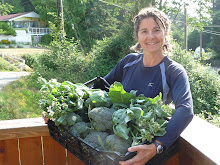You don't want to order too much because seed is expensive. You don't want to order too little because there is nothing more annoying than being ready to start seeding and discovering you are all out of seed. I tend to air on the side of being generous - most seed is okay the next year if you have too much.
There are many ways to approach ordering seed, I start off by pouring over the catalogues and start making a list of what I would like to grow, just a simple hand written list works for me. Now that I have a couple of years of experience under my belt I have a good base of plants that I know grow well and that I would like to grow again. However, there are always (too many) new varieties that I get all excited about trying. All the time I'm thinking about where a particular variety will be grown, where I will market it, and therefore how much of it I may need.

After making my first list (approx. 100 items!) I compare what seed I have left over from last year with what is on my list. I make notes along side indicating the quantity I have already. This will help me in determining the amount of seed to order.

Then I go online and order the seed - this year I ordered most of my seeds from Westcoast Seeds and William Dam Seeds, both Canadian companies, and I will be ordering a few specialty items from smaller seed companies on Vancouver Island too.

The nice thing about ordering online is that you can copy and paste the items you have ordered into an excel doc (yeah, no more typing everything out!). I have an excel doc that is my planting and harvesting schedule - all the items I have ordered are copied into this, then all that is left to do is to indicate seeding, transplanting and harvesting dates, and how much of each variety will be planted. That segues nicely into the next big job which is planning where and when to plant everything.
It is not smart to plant varieties in the same place each year because if you do you are increasing the odds of pest and disease problems, so a rotation system is needed. Along with the rotation system you need to be thinking about succession planting many items so that there is a constant supply. Also, many plants are early season varieties and others are main or late season - all these things must be taken into account when planning when and where they should go. It can all get quite overwhelming if you don't do a good amount of planning before the season starts. I generally start by drawing a physical map of each location and penciling in where things could go. It is like doing a large puzzle - lots of fun!! :o)

